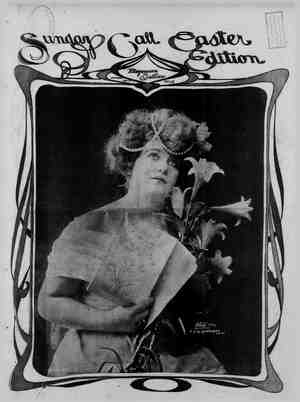The San Francisco Call. Newspaper, March 30, 1902, Page 13
You have reached the hourly page view limit. Unlock higher limit to our entire archive!
Subscribers enjoy higher page view limit, downloads, and exclusive features.
) @ T BY FHCLARK OR I HISTORY DROFFE £ g can the nts Still var- pledged illed t not be e n be one iitation. History hing the soul, by al insight, by of noble spirit. ng the past, | 1S are ever- repeated. of Arc has and, er, is compre- mee we is ‘used in a far »bler sense than to such as Cleo- could be re worthy of reverence and he loveliness of the ncere, courageous SOUI pired armies to success rescued France from de- beauty e have no definite record of | personal appearance of _Toan} rc. Necessarily she must| have had form and feature in| some way worthy of the beautiful ! t dwelt within. No bet-| can be gained of what| t have been than the de- 1 of the artist, Boutet de 10 spent years of study | ncidents of her life for pose of depicting her ca~ of his brush. He| ury Magazine for' at work on my series of | liave often been asked be my conception of arance of _]oan‘ s question I have| seen before me a figure by little s grown ¢ ct until n it is as an, to use her vith the eyes of my down to us of her vest- ent of her arms betwee: the iccount for the To somewhat > seems more fem on. me Leen J black kair; Hachette, who from the cpposed the eunemy battle-ax, was dark: put Arc had such a tender THE SUNDAY CALL. e s R DT oM PAINTING NG RES N THME | s B DARLE a ars oy 1, PR T % JsAan oF & RE heart—so much pity—I find in|hour of action that I can see her | b "'i her so much of womanly grace in| only blonde; not the blonde of l Pose by Miss Eby 0f the Tivoli. | | France. contrast with her decision in the| the fair-haired races of thenorth, | oo . . |sense pretty; T T T T e L] COSTUME FROM GOLOSTEIN AND TE a3 A o but the blonde chestnut of our|get that warlike companions, She was not in any|men not overburdened with we must not for- E_scruples, testified that she never inspired the thought of | If not pretty, however ‘}probably the be: ant; a firmly, well constructed head; her €yes we I | not too light, fi | at times; her nose w | heavy, but with sensitive no and her mouth strongly marked, with full, red lips. Her complex- ion was browned by exposure, rich and healthy in color; her car- riage free and somewhat boyish, for she was a girl of the fields, ty of the peas- free as air, and her limbs were vigorous, and her chest was deep. She never knew fatigue, say the chronicles of her time.” To many the career of Joan of Arc has seemed an inexplicable mystery; to some; a prmluc[ ol mere superstition. To view it aright one must study it in rela- tion to the condition of the time, as one would study the work ot Julius Caesar or of Abraham Lincoln. What was the Fra for which Joan of Arc lived |angel of healing, and died, a martyr? At the end of the tenth century Francewas afeudally divided land with ten thousand separate fiefs and a score of great lords, any one of them equal to the King in power. By the end of the thir- teenth century a long road had been traveled toward national unity. Private warfare had been forbidden; uniformity of law had been established; the authcrity of the King’s courts was recog- nized. Stiil the goal had not y been reached; and a succession of weak sovereigns and the evils | of the endless wars with the Eng- lish sent the nation far backward course. Provir broke away from province. The | great Dukes sought to recover | their lost power, the ce an on | ruins of | ples of thei | There were no Frenchmen [Burglmdzans, Armagnacs, Bret- ons, Provencaux. To such a de- | gree of bitterness and hatred did ‘}men carry their partisan -only strife | that either Side ‘was ready to wel- | come the foreigm mvader rather }th;m see the success of the rival | faction. Such was the condition of France during the childhood of Joan of Arc, born January 3, 1412. The battle of Agincourt, | fought three years later, gave | half of France'into the hands of Henry V of England. In 1420 came “le traite infame” of Treyes | by which the conqueror gained the daughter of the King of France ior his bride, the regency and the promise of the throne upon the King’s death—and all this with French help against France. Who could rescue France from this depth of degradation? Whe could unite the warring factione against the invader? What | denied to princes and cas was granted to the p: of Domremy. To save Fra was the mission of Joan of Arc History contains nothing more wonderful than this 1l yetit is nothing supernatural. It is natural as the rainfall reple ing the thirsty earth. Fra in ruins through p Only the spirit of | could rebuild and restore. of Arc was the embodimen that spirit. In her was made tlesh and dwelt among was mns Joan t of patriotism Continued on Page Fourteem.

